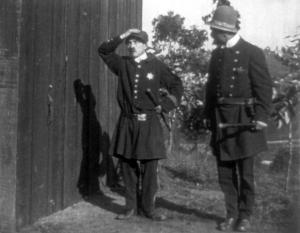A LOST Charlie Chaplin film has been discovered at an antiques show in America.
The 10-minute silent film – a Keystone comedy called A Thief Catcher – features the English comic actor in a cameo role. It is reckoned to be one of the first, if not the first, cinematic outing for his famed ‘Tramp’ character.
The 16mm print was found last year in Michigan by internationally respected film historian and collector Paul Gierucki.
Gierucki says he didn’t get round to viewing the print until March this year – thinking it was just another old Keystone comedy.
But when he did, he spotted an unmistakable moustached Keystone Kop and realised he was watching a previously unknown Chaplin film.
He confirmed his find with fellow collector Richard Roberts, sending along a frame grab.
Though Chaplin’s Tramp character was first presented to the public in Kid Auto Races at Venice (released Feb 7, 1914), it was filmed AFTER Mabel’s Strange Predicament, which hit cinemas two days later, on Feb 9.
A Thief Catcher, though, began production on January 5, 1914 – one day before Mabel’s Strange Predicament started shooting.
Roberts said: “It’s either his second moustache picture or his first. It cements the concept that he had the character before he came to Keystone and didn’t slap it together on the way to the shooting stage one day.
“Even when he’s doing a minor part he’s doing that character. It’s a new brick in the Chaplin biography. And this opens up the door to other unknown Chaplin appearances at Keystone.”
A Thief Catcher stars Ford Sterling, Mack Swain and Edgar Kennedy. It was the 36th film Chaplin made and he appears on-screen for around three minutes.
It was filmed about a month after Chaplin started work at Keystone Studios, in Edendale, California, and was released by the Mutual Film Corporation on February 19, 1914.
According to Roberts, the film “fell through the cracks pretty quickly” and was not included in a Chaplin filmography compiled by the British Film Institute in the late 1930s.
Until its discovery, the short – which is said to be in “decent” condition – was thought to be among the estimated 75 per cent of all silent films that have not survived to the present day.
- A Thief Catcher will get its first showing in over 90 years at Slapstickon, a comedy film convention in Rosslyn, Virginia, on July 17. You can read more about the discovery on the Washington Post website.


















